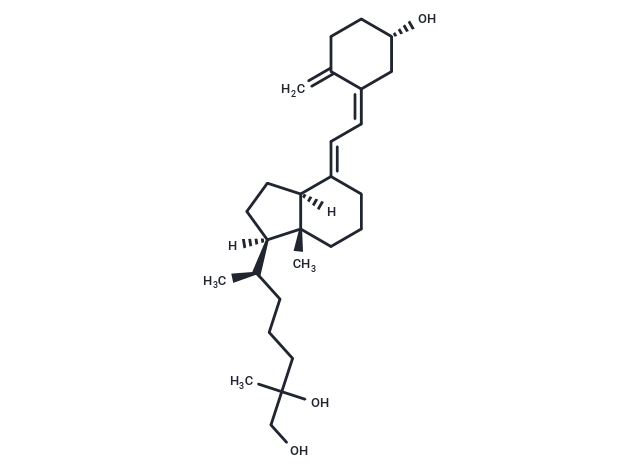Shopping Cart
- Remove All
 Your shopping cart is currently empty
Your shopping cart is currently empty

25,26-Dihydroxyvitamin D3 (25,26-Dihydroxycholecalciferol) is a vitamin D3 metabolite and a precursor compound for the synthesis of 25-hydroxyvitamin D.

| Pack Size | Price | Availability | Quantity |
|---|---|---|---|
| 1 mg | $2,318 | Backorder |
| Description | 25,26-Dihydroxyvitamin D3 (25,26-Dihydroxycholecalciferol) is a vitamin D3 metabolite and a precursor compound for the synthesis of 25-hydroxyvitamin D. |
| In vitro | 24,25 and 25,26 diOHD3 (0.125-0.250 mug) were able to increase calcium absorption in rats maintained on a calcium-deficient diet, but failed to do it in rats on a normal calcium diet. Bilateral nephrectomy suppressed this effect. The 'bone calcium mobilization' of both derivatives was measured in vitamin D and calcium- or phosphorus-deprived rats after one intravenous dose. When serum calcium was initially low, 24,25 and 25,26 diOHD3 increased serum calcium moderately, but the increment was only significant with 24,25 diOHD3 [2]. |
| In vivo | 24,25 and 25,26-Dihydroxyvitamin D3 (0.125-0.250 mug) were able to increase calcium absorption in rats maintained on a calcium-deficient diet, but failed to do it in rats on a normal calcium diet. Bilateral nephrectomy suppressed this effect. The "bone calcium mobilization" of both derivatives was measured in vitamin D and calcium- or phosphorus-deprived rats after one intravenous dose. When serum calcium was initially low, 24,25 and 25,26-Dihydroxyvitamin D3 increased serum calcium moderately, but the increment was only significant with 24,25-Dihydroxyvitamin D3 [2]. |
| Alias | 25,26-Dihydroxycholecalciferol |
| Molecular Weight | 416.64 |
| Formula | C27H44O3 |
| Cas No. | 29261-12-9 |
| Smiles | C[C@@]12[C@](\C(=C\C=C\3/C(=C)CC[C@H](O)C3)\CCC1)(CC[C@@]2([C@@H](CCCC(CO)(C)O)C)[H])[H] |
| Relative Density. | 1.06g/cm3 |
| Storage | keep away from direct sunlight,store at low temperature | Powder: -20°C for 3 years | In solvent: -80°C for 1 year | Shipping with blue ice. | |||||||||||||||||||||||||||||||||||
| Solubility Information | DMSO: 80 mg/mL (192.01 mM.), Sonication is recommended. | |||||||||||||||||||||||||||||||||||
Solution Preparation Table | ||||||||||||||||||||||||||||||||||||
DMSO
| ||||||||||||||||||||||||||||||||||||

Copyright © 2015-2025 TargetMol Chemicals Inc. All Rights Reserved.